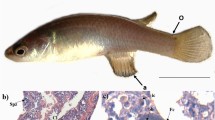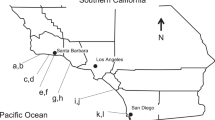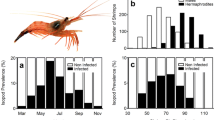Abstract
Sex allocation theory for sequential hermaphrodites predicts the size at which an individual should change sex, given the different relationships between individual size and reproductive success in the two sexes. We studied a host-parasite system where the myxozoan Kudoa ovivora infects the ovaries of the reef fish Thalassoma bifasciatum, a protogynous sequential hermaphrodite. The parasite sporulates in the host’s eggs and renders them infertile. It is thus expected to reduce the female’s reproductive success, and could thereby influence host sex change. We present data from marked fish we observed in the field over 4 months. The data suggest that females infected with Kudoa ovivora have a lower reproductive success, change sex earlier and at a smaller size than uninfected females. These results are in agreement with predictions from sex allocation theory, and provide the first example of a possible parasitic influence on the sex allocation of its host.



Similar content being viewed by others
References
Charnov EL (1982) The theory of sex allocation, vol 18. Princeton University Press, Princeton, NJ
Frank SA (1996) Models of parasite virulence. Q Rev Biol 71:37–78
Frederick JL (1997) Evaluation of fluorescent elastomer injection as a method for marking small fish. Bull Mar Sci 61:399–408
Ghiselin MT (1969) The evolution of hermaphroditism among animals. Q Rev Biol 44:189–208
Malone JC, Forrester GE, Steele MA (1999) Effects of subcutaneous microtags on the growth, survival, and vulnerability to predation of small reef fishes. J Exp Mar Biol Ecol 237:243–253
Marconato A, Shapiro DY, Petersen CW, Warner RR, Yoshikawa T (1997) Methodological analysis of fertilization rate in the bluehead wrasse Thalassoma bifasciatum: pair versus group spawns. Mar Ecol Prog Ser 161:61–70
Moran JDW, Whitaker DJ, Kent ML (1999a) Natural and laboratory transmission of the marine myxozoan parasite Kudoa thyrsites to Atlantic salmon. J Aquat Anim Health 11:110–115
Moran JDW, Whitaker DJ, Kent ML (1999b) A review of the myxosporean genus Kudoa Meglitsch, 1947, and its impact on the international aquaculture industry and commercial fisheries. Aquaculture 172:163–196
Robertson DR, Swearer SE, Kaufmann K, Brothers EB (1999) Settlement vs. environmental dynamics in a pelagic-spawning reef fish at Caribbean Panama. Ecol Monogr 69:195
Sall J, Lehman A (1996) JMP start statistics: a guide to statistical and data analysis using JMP and JMPIN software. Duxbury, Belmont
SAS Institute Inc. (2000) JMP statistics and graphics guide, version 4. SAS Institute, Cary, NC
Schultz ET, Warner RR (1991) Phenotypic plasticity in life-history traits of female Thalassoma bifasciatum (Pisces: Labridae). 2. Correlation of fecundity and growth rate in comparative studies. Environ Biol Fish 30:333–344
Siegel S, Castellan NJ (1988) Nonparametric statistics for the behavioral sciences, 2nd edn. McGraw-Hill, New York
Swearer SE, Robertson DR (1999) Life history, pathology, and description of Kudoa ovivora n. sp. (Myxozoa, Myxosporea): an ovarian parasite of Caribbean labroid fishes. J Parasitol 85:337–353
Victor BC (1986) Duration of the planktonic larval stage of one hundred species of Pacific and Atlantic wrasses. Mar Biol 90:317–326
Warner RR (1975) The adaptive significance of sequential hermaphroditism in animals. Am Nat 109:61–82
Warner RR (1988) Sex change and the size-advantage model. Trends Ecol Evol 3:133–136
Warner RR, Hoffman SG (1980a) Local population size as a determinant of mating system and sexual composition in two tropical marine fishes (Thalassoma spp.). Evolution 34:508–518
Warner RR, Hoffman SG (1980b) Population density and the economics of territorial defense in a coral reef fish. Ecology 61:772–780
Warner RR, Swearer SE (1991) Social control of sex change in the bluehead wrasse, Thalassoma bifasciatum (Pisces: Labridae). Bioll Bull 181:199–204
Warner RR, Robertson DR, Leigh EG Jr (1975) Sex change and sexual selection. Science 190:633–638
Acknowledgements
We thank Todd Catalini, Arturo Dominici, Trimurti Irzan, Caroline Joris, Kuno von Wattenwyl, and Jono Wilson for excellent field assistance, and the Smith family for their hospitality at Crawl Cay. Furthermore, we would like to thank the staff of the Smithsonian Tropical Research Institute for invaluable support, particularly Harry Barnes and Luis Mou Sue for support in Bocas del Toro, and John Christy, Arturo Dominici, Allen Herre, Bailey Kessing, Harilaos Lessios and Ross Robertson for support in Panama City. This project profited greatly from discussions with Jacob Koella, Nico Michiels, Steve Swearer, and the participants of the 1998 Population Biology Seminar in Guarda, particularly Mette Hansen. We also thank Anders Berglund, Jacob Koella, Nico Michiels, and Steve Swearer for helpful comments on the manuscript. During this study L.S. was supported by a poste rouge (CNRS, France), an IHP fellowship (SNF, Switzerland), and research funds from the Novartis Foundation, the Janggen-Pöhn-Stiftung, and the Kommission für Reisestipendien of the Swiss Academy of Natural Sciences. D.B.V. was supported by CONICIT (Venezuela). The research was carried out in accordance to Panamanian law.
Author information
Authors and Affiliations
Corresponding author
Additional information
Communicated by P. Heeb
Rights and permissions
About this article
Cite this article
Schärer, L., Vizoso, D.B. Earlier sex change in infected individuals of the protogynous reef fish Thalassoma bifasciatum . Behav Ecol Sociobiol 55, 137–143 (2003). https://doi.org/10.1007/s00265-003-0694-0
Received:
Accepted:
Published:
Issue Date:
DOI: https://doi.org/10.1007/s00265-003-0694-0




